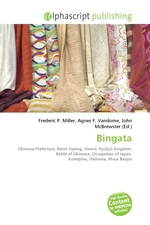Bingata
Frederic P. Miller, Agnes F. Vandome, John McBrewster
бумажная книга
Please note that the content of this book primarily consists of articles available from Wikipedia or other free sources online. Bingata (literally "red style") is an Okinawan traditional resist dyed cloth, made using stencils and other methods. It is generally bright-colored and features various patterns, usually depicting natural subjects such as fish, water, and flowers. Bingata is worn during traditional Ryukyu arts performances and historical reinactments. Bingata dates from the Ryukyu Kingdom period (c. 14th century), when the island of Okinawa experienced an influx of foreign goods and manufacturing techniques. It is believed to have developed as a synthesis of Indian, Chinese, and Javanese dying processes. Bingata is a type of stencil dyed fabric originating from the island of Okinawa. The techniques used are thought to have originated in Southeast Asia (possibly Java, or perhaps China or India) and arrived in Okinawa through trade during the 14th century (Nakai). The Ryukyu Kingdom "dominated trade between Korea, Japan, China, and the countries of Southeast Asia in the fifteenth and sixteenth centuries" (Nakai).
Данное издание не является оригинальным. Книга печатается по технологии принт-он-деманд после получения заказа.


